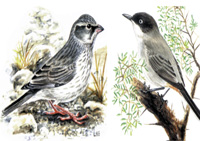
Birds in Yemen [Archives:2006/970/Last Page]
August 7 2006
 |
Several birds unknown in the Arab and Islamic world come here in certain seasons to breed. Among them are African birds that come during Yemen's spring rainy season to build their nests and raise their babies.
In winter, different types of birds come from the north, particularly Europe and Russia, to escape cold weather there. These birds spend the winter in Yemen's mountains and coasts, where it's easy to catch food and then return to their original locales to breed in spring.
Located in the southern Arabian Peninsula, Yemen has become a station through which thousands, and perhaps millions, of birds pass twice a year on their long journey between South Africa and Europe and Asia.
Though Yemen is filled with different types of settling birds, it also hosts migrating birds from various areas across the world in certain seasons.
Bird locations
Mountains
Yemeni highlands contain their own unique birds, some of which can live in deserted and dire places, like the Philby's Rock Partridge. They sometimes move to lowlands with the change of seasons and temperature.
The Tihama Red Sea coastal plain is the original habitat of Al-Habari Al-Arabi (Arabian Bustard), which has adapted itself to live on Yemeni crops. Further, other bird species live in the Tihama's Al-Sumur Forest.
Sweetwater swamps
These are rare in Yemen and can be traced somewhere near Taiz city and in some southern valleys. These are good locations to see water birds during winter, particularly the Abu Mingal Al-Asla'a (Baldibis), which is on the verge of extinction.
Coast
In protected gulfs with sand and mud accumulation or in places where valleys meet with the sea and following heavy rains, a considerable number of worms, snails and small lobsters exist, upon which coastal birds can feed. When the tide rises, these birds feed from mud and water pools. The best known among these birds is Zikzak Al-Saratan (Crab Player).
Sea
Most sea birds depend on the sea filled with fish as a natural environment for food. Numerous birds need quiet islands in order to breed and increase in peace.
Source:High Authority for Environment Protection
——
[archive-e:970-v:14-y:2006-d:2006-08-07-p:lastpage]


